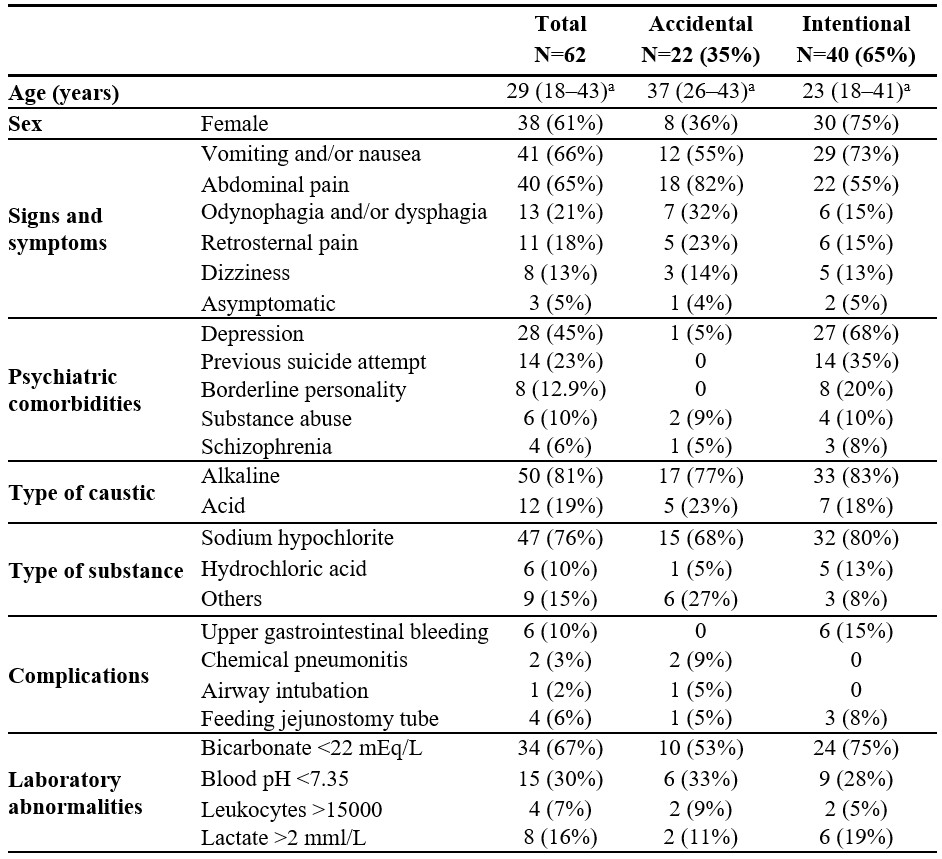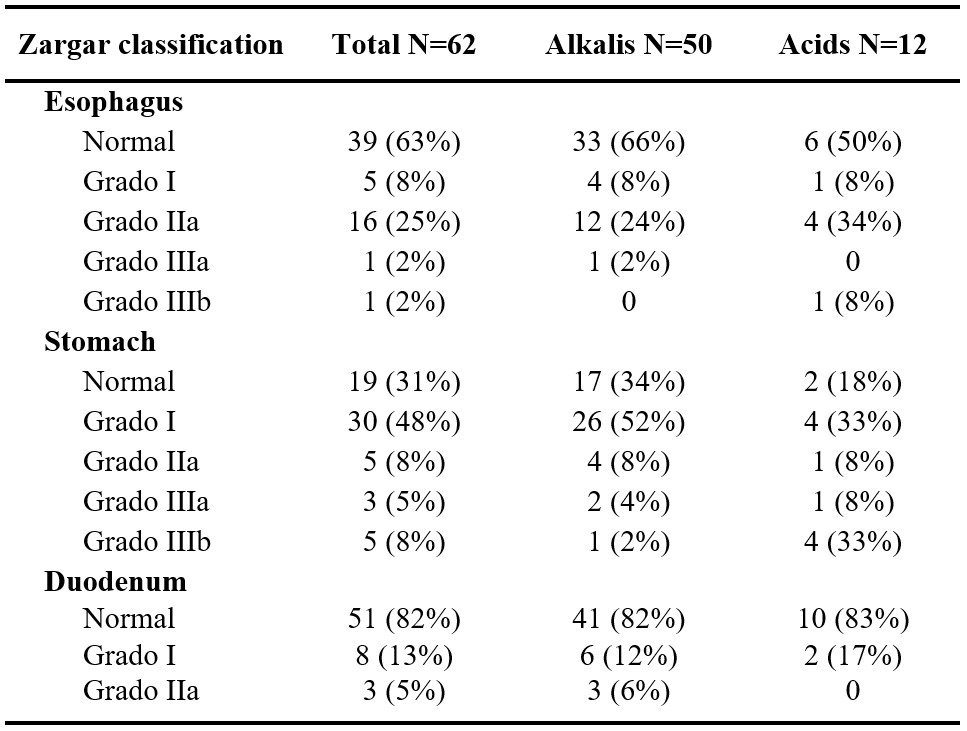Monday Poster Session
Category: Esophagus
P2802 - Clinical and Endoscopic Features of Caustic Ingestion: A Retrospective Study From a Referral Center in Peru
Monday, October 27, 2025
10:30 AM - 4:00 PM PDT
Location: Exhibit Hall

David Guevara-Lazo, MD (he/him/his)
University of Michigan
Ann Arbor, MI
Presenting Author(s)
David Guevara-Lazo, MD1, Mayumi Tacuri-Arqque, MD2, Gerard Sotelo-Bueno, MD2, Alvaro Bellido-Caparó, MD2
1University of Michigan, Ann Arbor, MI; 2Universidad Peruana Cayetano Heredia, Lima, Lima, Peru
Introduction: Caustic substance ingestion can result in serious gastrointestinal injuries and long-term complications. In low- and middle-income countries, limited access to mental health care, and delays in specialized treatment further exacerbate this issue. This study aims to describe the clinical and endoscopic features of caustic ingestion.
Methods: We conducted a retrospective review of medical records from adults admitted for caustic ingestion at a referral hospital in Peru from June 2020 to July 2024. All patients underwent endoscopy, and those with intentional ingestion received a psychiatric evaluation. Mucosal injury severity was graded using the Zargar classification. Descriptive analysis using StataSE was performed.
Results: Sixty-two cases were included (median age, 29 years [IQR 18–43]; 61% female). Intentional ingestion accounted for 65% of cases. Common symptoms were vomiting/nausea (66%), abdominal pain (65%), and odynophagia/dysphagia (21%). Psychiatric comorbidities were more common in intentional cases: depression (68%), prior suicide attempts (35%), and borderline personality disorder (20%). Alkalis were more frequently ingested (81%), but acid ingestion was most common in severe gastric injuries (Grade IIIb, 33%). Endoscopy showed a normal duodenum in 82% and esophagus in 63%. Esophageal injuries were mostly mild; only 2% had Grade IIIb lesions. Zargar grade IIa esophageal injuries occurred in 25%. The stomach was normal in 31%, while 48% had grade I injuries. Upper gastrointestinal bleeding occurred in 10% of cases, all in the intentional group. Other complications included chemical pneumonitis (3%) and need for jejunostomy (6%), acidemia (30%), and elevated lactate (16%).
Discussion: This is one of the most comprehensive studies on caustic ingestion in Latin America. Our findings highlight that intentional ingestion, often associated with psychiatric comorbidities, was the most common cause. Despite the potential for severe injury, most patients had normal or mild endoscopic findings. These results emphasize the importance of early endoscopic and psychiatric evaluation in cases of intentional ingestion.

Figure: Clinical characteristics of adult patients with caustic ingestion

Figure: Zargar classification of the esophagus, stomach and duodenum by the type of ingested caustic
Disclosures:
David Guevara-Lazo indicated no relevant financial relationships.
Mayumi Tacuri-Arqque indicated no relevant financial relationships.
Gerard Sotelo-Bueno indicated no relevant financial relationships.
Alvaro Bellido-Caparó indicated no relevant financial relationships.
David Guevara-Lazo, MD1, Mayumi Tacuri-Arqque, MD2, Gerard Sotelo-Bueno, MD2, Alvaro Bellido-Caparó, MD2. P2802 - Clinical and Endoscopic Features of Caustic Ingestion: A Retrospective Study From a Referral Center in Peru, ACG 2025 Annual Scientific Meeting Abstracts. Phoenix, AZ: American College of Gastroenterology.
1University of Michigan, Ann Arbor, MI; 2Universidad Peruana Cayetano Heredia, Lima, Lima, Peru
Introduction: Caustic substance ingestion can result in serious gastrointestinal injuries and long-term complications. In low- and middle-income countries, limited access to mental health care, and delays in specialized treatment further exacerbate this issue. This study aims to describe the clinical and endoscopic features of caustic ingestion.
Methods: We conducted a retrospective review of medical records from adults admitted for caustic ingestion at a referral hospital in Peru from June 2020 to July 2024. All patients underwent endoscopy, and those with intentional ingestion received a psychiatric evaluation. Mucosal injury severity was graded using the Zargar classification. Descriptive analysis using StataSE was performed.
Results: Sixty-two cases were included (median age, 29 years [IQR 18–43]; 61% female). Intentional ingestion accounted for 65% of cases. Common symptoms were vomiting/nausea (66%), abdominal pain (65%), and odynophagia/dysphagia (21%). Psychiatric comorbidities were more common in intentional cases: depression (68%), prior suicide attempts (35%), and borderline personality disorder (20%). Alkalis were more frequently ingested (81%), but acid ingestion was most common in severe gastric injuries (Grade IIIb, 33%). Endoscopy showed a normal duodenum in 82% and esophagus in 63%. Esophageal injuries were mostly mild; only 2% had Grade IIIb lesions. Zargar grade IIa esophageal injuries occurred in 25%. The stomach was normal in 31%, while 48% had grade I injuries. Upper gastrointestinal bleeding occurred in 10% of cases, all in the intentional group. Other complications included chemical pneumonitis (3%) and need for jejunostomy (6%), acidemia (30%), and elevated lactate (16%).
Discussion: This is one of the most comprehensive studies on caustic ingestion in Latin America. Our findings highlight that intentional ingestion, often associated with psychiatric comorbidities, was the most common cause. Despite the potential for severe injury, most patients had normal or mild endoscopic findings. These results emphasize the importance of early endoscopic and psychiatric evaluation in cases of intentional ingestion.

Figure: Clinical characteristics of adult patients with caustic ingestion

Figure: Zargar classification of the esophagus, stomach and duodenum by the type of ingested caustic
Disclosures:
David Guevara-Lazo indicated no relevant financial relationships.
Mayumi Tacuri-Arqque indicated no relevant financial relationships.
Gerard Sotelo-Bueno indicated no relevant financial relationships.
Alvaro Bellido-Caparó indicated no relevant financial relationships.
David Guevara-Lazo, MD1, Mayumi Tacuri-Arqque, MD2, Gerard Sotelo-Bueno, MD2, Alvaro Bellido-Caparó, MD2. P2802 - Clinical and Endoscopic Features of Caustic Ingestion: A Retrospective Study From a Referral Center in Peru, ACG 2025 Annual Scientific Meeting Abstracts. Phoenix, AZ: American College of Gastroenterology.
